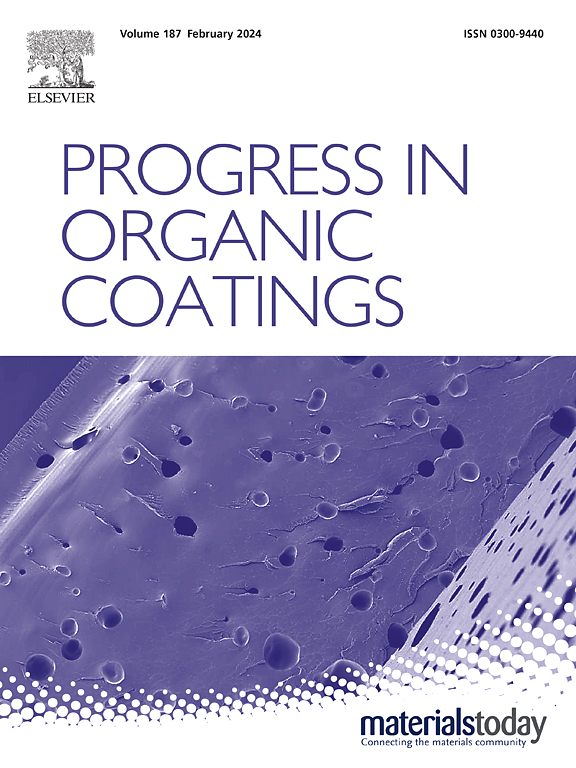All-in-one in-situ constructed neutral inhibitors entrapped polyaniline fibers enable robust anti-corrosion polymer coatings
IF 6.5
2区 材料科学
Q1 CHEMISTRY, APPLIED
引用次数: 0
Abstract
Polyaniline (PANI) is widely employed as a filler to boost the corrosion resistance of organic coatings, leveraging its notable passivation ability and redox properties. However, its efficacy in protecting against corrosion is mainly confined to small defects such as pinholes due to the specific redox characteristics of PANI and the counterions it releases, which restricts further improvements in anticorrosive performance. To extend the repair capability of PANI fibers to large damaged areas, we propose entrapping neutral corrosion inhibitors within the PANI fibers. This was achieved by preparing benzotriazole (BTA)-entrapped HCl or sulfosalicylic acid (SSA)-doped PANI fibers through a one-step chemical oxidative polymerization process. The effects of various counterions and neutral inhibitors on corrosion protection were explored. A comprehensive release experiment examined unwashed and washed BTA-entrapped HCl or SSA-doped PANI fibers, confirming their pH-responsive controlled release capabilities. The results indicated that incorporating these fibers into polyvinyl butyral (PVB) coatings significantly enhances anti-corrosive performance compared to coatings without entrapped neutral corrosion inhibitors. Specifically, the low frequency impedance magnitude for PANI-SSA-BTA/PVB and PANI-HCl-BTA/PVB coatings increased by sixfold and elevenfold, respectively, over the pure PVB coating. This enhanced performance is attributed to the synergistic effect of the passivation of PANI fibers and the controlled release of BTA. The development of neutral corrosion inhibitors entrapped within acid-doped PANI represents an innovative approach to creating high-performance anticorrosion coatings, holding significant potential for advancing applications in corrosion protection.
一体化原位构建中性抑制剂包埋聚苯胺纤维使坚固的防腐聚合物涂层
聚苯胺(PANI)利用其显著的钝化能力和氧化还原性能,被广泛用作有机涂料的防腐填料。然而,由于聚苯胺特有的氧化还原特性及其释放的反离子,其防腐效果主要局限于针孔等小缺陷,限制了其防腐性能的进一步提高。为了将聚苯胺纤维的修复能力扩展到大面积受损区域,我们建议在聚苯胺纤维中包裹中性缓蚀剂。这是通过一步化学氧化聚合法制备苯并三唑(BTA)包埋HCl或磺基水杨酸(SSA)掺杂聚苯胺纤维实现的。探讨了各种反离子和中性缓蚀剂的防腐效果。一项全面的释放实验检测了未洗涤和洗涤bta捕获的HCl或ssa掺杂的聚苯胺纤维,证实了它们的ph响应控制释放能力。结果表明,与未包埋中性缓蚀剂的涂料相比,将这些纤维掺入聚乙烯醇丁醛(PVB)涂料中可以显著提高涂料的防腐性能。具体而言,PANI-SSA-BTA/PVB和pani - hl - bta /PVB涂层的低频阻抗值分别比纯PVB涂层提高了6倍和11倍。这种增强的性能归因于聚苯胺纤维的钝化和BTA的可控释放的协同作用。在酸掺杂聚苯胺中包裹中性缓蚀剂的发展代表了一种创造高性能防腐涂层的创新方法,在推进防腐应用方面具有巨大的潜力。
本文章由计算机程序翻译,如有差异,请以英文原文为准。
求助全文
约1分钟内获得全文
求助全文
来源期刊

Progress in Organic Coatings
工程技术-材料科学:膜
CiteScore
11.40
自引率
15.20%
发文量
577
审稿时长
48 days
期刊介绍:
The aim of this international journal is to analyse and publicise the progress and current state of knowledge in the field of organic coatings and related materials. The Editors and the Editorial Board members will solicit both review and research papers from academic and industrial scientists who are actively engaged in research and development or, in the case of review papers, have extensive experience in the subject to be reviewed. Unsolicited manuscripts will be accepted if they meet the journal''s requirements. The journal publishes papers dealing with such subjects as:
• Chemical, physical and technological properties of organic coatings and related materials
• Problems and methods of preparation, manufacture and application of these materials
• Performance, testing and analysis.
 求助内容:
求助内容: 应助结果提醒方式:
应助结果提醒方式:


